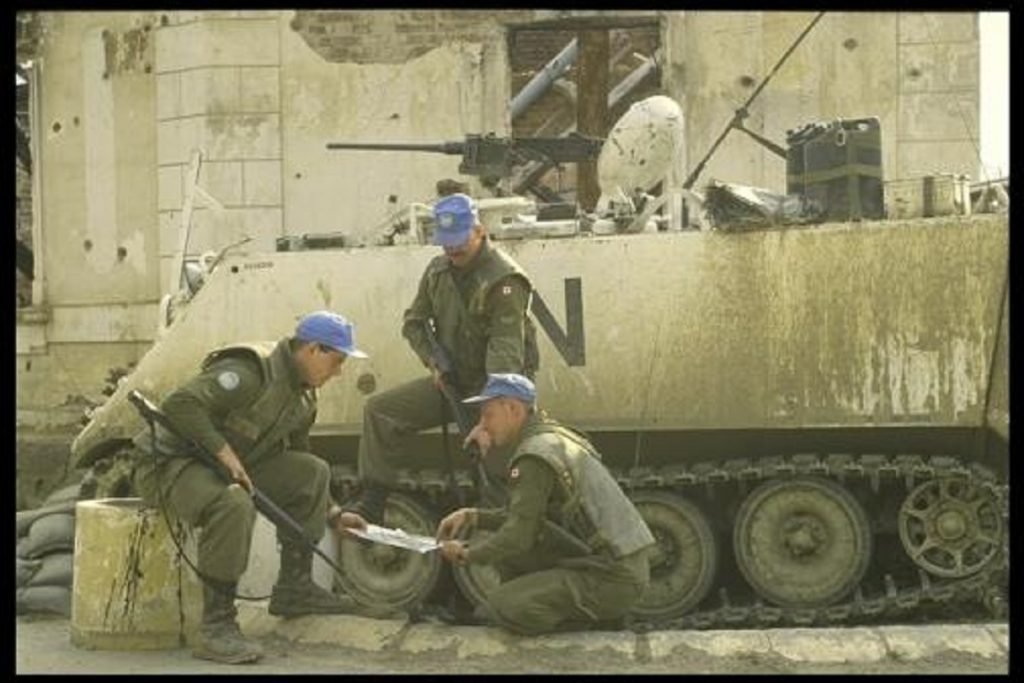The peak of tensions between Croatian police, civilians and the United Nations Protection Force (UNPROFOR) in western Slavonia occurred on 3 October 1994 in Donji Čaglić near Lipik.
Bukovčanska Street in Donji Čaglić was the local portion of the main road between Lipik and Okučani that led to Šeovica and the occupied area of Pakrac. In battles to liberate occupied land at the end of 1991, the Croatian army took up positions at the intersection of Bukovčanska Street and the main road while the Yugoslav People’s Army (YPA) and rebel Serbs withdrew and regrouped approximately 1,500 metres south towards Okučani. This created a ”no man’s land” that was disputed until Croats regained control of the area during Operation “FLASH” in the spring of 1995. Although the dispute seemed trivial, possession of this intersection was important to both sides as it allowed Croats to cross the Pakra River, 600 metres to the north and a natural obstacle towards Lipik while for Serbs it was the only paved road between the occupied areas on the slopes of Psunj Mountain and Okučani.
During its deployment in July 1992, UNPROFOR set up its checkpoint further south, practically in front of Serb positions while the Croatian police set up their checkpoint northwards in “no man’s land”. This remained the status quo until January 1993 when the Canadian battalion of UNPROFOR, for strategic reasons, moved its checkpoint practically at the entrance to Lipik which caused the Croatian police to lose control of the important intersection. This enabled terrorist groups to re-enter the area and made it impossible for local Croats to continue rebuilding their homes.
Tensions first arose in July 1994 when civilians from Pakrac, Lipik were joined by others from throughout Croatia in blocking official crossings between the Croatian and Serb parts of the Sector in protest against UNPROFOR’s ineffectiveness. The blockade ended in August but it was only the beginning of heightening tensions between the Croats and UNPROFOR at Lipik.
When the aforementioned protests ended, the Croatian police established a checkpoint right at the intersection of Bukovčanska Street and the main road to Okučani and again took control of the disputed location. UNPROFOR then blocked the Croatian police with wire fencing and anti-tank barriers at the end of September but that was removed by an intervention group from Pakrac. After the blockade was re-established two days later, approximately seventy civilians gathered and took down the UNPROFOR obstacles with the help of a tractor. They were on the brink of armed conflict and amidst this chaos Serbs briefly opened fire from nearby positions. On this day in 1994, the Jordanian UNPROFOR battalion was reinforced with an Argentine battalion and civilians confronted them with tractors loaded with wood and fuel canisters, threatening to set fire to an UNPROFOR transport vehicle. Two UNPROFOR personnel were injured during the incident which forced them finally withdraw.
The dispute was finally resolved on 28 October when UNPROFOR and Croatian police checkpoints were opened alongside one another, ten metres from the intersection of Bukovčanska Street and the main road to Okučani, with which the Croatian police ultimately regained control of the area.
Magistar sam povijesti. Radno iskustvo stjecao sam u Hrvatskom povijesnom muzeju i na Hrvatskoj radioteleviziji u emisiji TV Kalendar. Autor sam nekoliko knjiga i filmova na temu Domovinskog rata. Osnovao sam i uređujem Facebook stranicu Dogodilo se na današnji dan – Domovinski rat i portal Domovinskirat.hr. Također uređujem i vodim emisiju Domoljubne minute koja se svakog dana emitira na Hrvatskom katoličkom radiju te emisiju Sve za Hrvatsku i Novi valovi dobrote. Vlasnik sam obrta CroHis kojim promičem vrijednosti Domovinskog rata.

